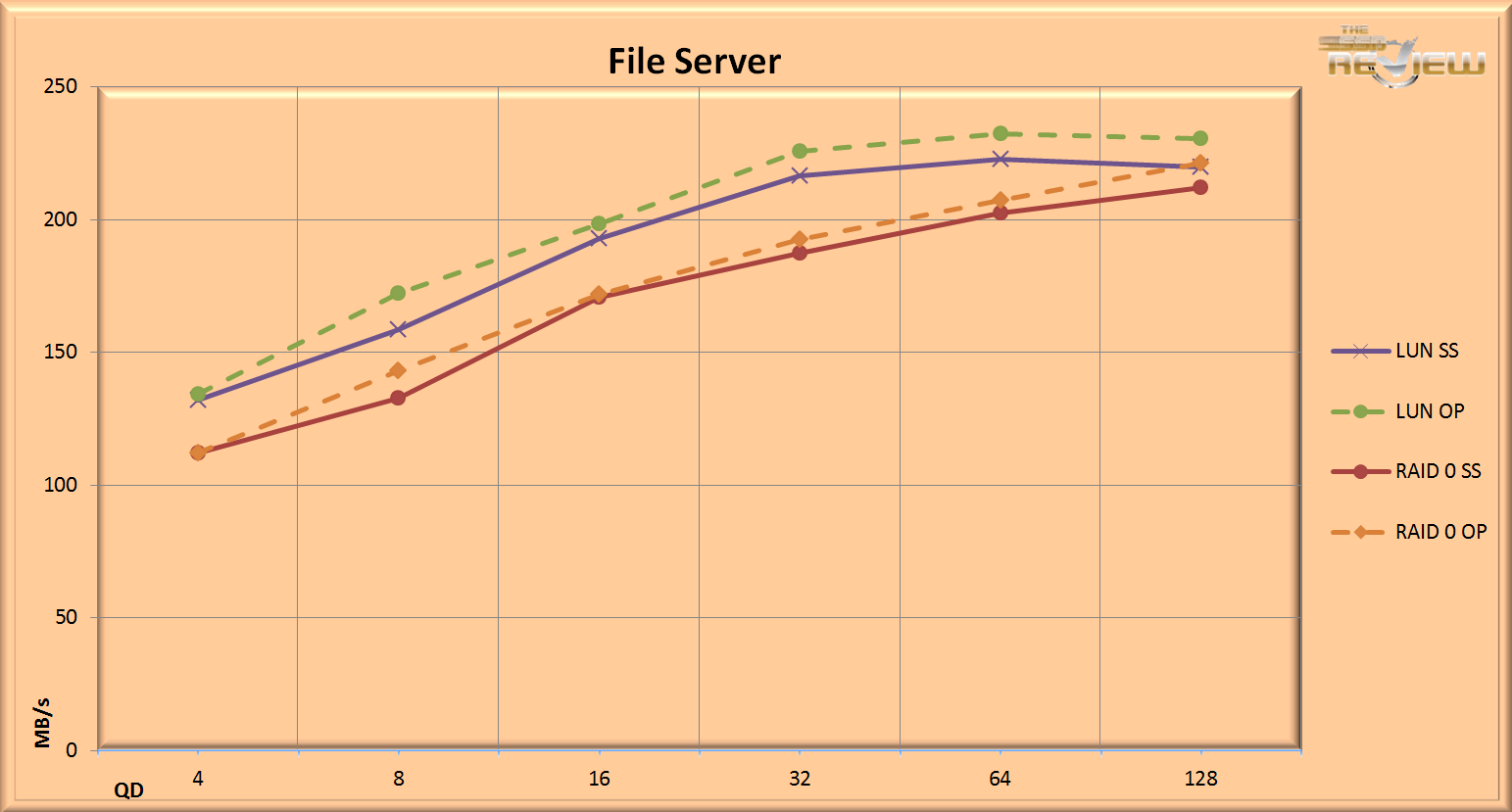400 GB SERVER PROFILES
The File Server profile emulates usage in a file server environment with a vast range of file sizes being accessed simultaneously. This type of file access is 80% read and 20% write.
Both configurations perform well, with the two separate LUN volumes coming up slightly higher. The LUN results in steady state reach 232MB/s at QD32, while the RAID results reach 202MB/s at QD64.
The Email profile is an emulation of a mail server, with a 50% Read and 50% Write mixed workload with very small 8KB files. This can be a very stressful test for even the best of drives.
Again the overprovisioned RAID 0 results come out on top, with 146MB/s at QD128. The RAID 0 steady state results come in at a high of 140MB/s at QD64. 
The Database/OLTP (On-Line Transaction Processing) profile is another heavy-usage type of access that can bring many drives, even those with superior write performance, to their knees given Steady State conditions. With small 8K random data being read at 66% and written simultaneously at 33%, this is a very demanding workload.
This type of application is sure to be one of the environments that this SSD will deploy into, with PCIe SSDs already enjoying great penetration into the financial sector. Low latencies and high workload performance are attributes that are almost tailor made for OLTP processing, and here the 910 delivers.
Leveraging two separate volumes produces the best results with this type of access, with a top speed of 173MB/s at QD64. 
The Web Server profile is read only over a wide range of file sizes simultaneously. There is little variation in the results with this type of 100% read access. Both configurations score between 480MB/s and 500MB/s. 
 The SSD Review The Worlds Dedicated SSD Education and Review Resource |
The SSD Review The Worlds Dedicated SSD Education and Review Resource | 
Simply Outstanding Review Paul!
Thanks, this one was my pleasure for sure. The 910 is one of the best SSDs that i have been lucky enough to test. Really shes a beast, just an awesome performer 🙂
When is this hitting the market? I can’t find it anywhere…
This looks like a dream product for VMware folks. Would it be possible to have PCI SSD reviews indicate whether the vendor supports multi-slot usage of the product?
This is going to ROCK with nexenta or any other ZFS product. 2 of those with 4 mirrored drives across those 2 cards…. cant wait enough to test it behind SVC as tier0
I just purchased the 800 GB 910 recently. I wish I would have read this article first because Intel’s documentation is abysmal on two important points (1) you cannot boot from the device, and (2) it appears as 4 devices to the system.
My application is a workstation and I would have liked to be able to boot the O/S from a single 800 GB drive in order to keep things simple. I would have preferred they implemented a hardware RAID controller.
Currently I have it configured in RAID 0 from Windows 7 and the first thing I did was put the paging file there (192 GB) which helps the overall system performance. Also, I have my RAM Disk backing store there so rebooting or shutting down the system is much faster now.
I am interested in tiered storage solutions – can anyone provide a references for something that might work?
Hey guys, what about security? Is there any way to have two of those cards mirrored? In case this card is used to store data files for e.g. an OLTP database it might dramatically increase database performance, but it NEEDS to be 100% bulletproof and data secure! Any ideas?
Yep, since it appears as 2 logical drives to the OS, you can do RAID 1 with the 400 GB (2 logical) and even RAID 5/6 with the 800 GB version (4 logical drives).
El mundo incrible